Services and Relationship Marketing: Service Failure and Recovery
VerifiedAdded on 2023/06/15
|10
|3217
|69
Essay
AI Summary
This essay explores the critical aspects of service failure, complaint handling, and service recovery within the framework of services and relationship marketing. It analyzes various journal articles that highlight the importance of service characteristics like intangibility, inseparability, perishability, and variability in service delivery. The essay discusses strategies for preventing service failures, addressing customer complaints effectively, and implementing service recovery methods to maintain customer satisfaction and loyalty. A case study illustrates a service failure scenario and applies an eight-fold strategy for service recovery, including cost analysis of both tangible and intangible losses. The conclusion emphasizes the significance of proactive complaint management and continuous improvement to foster strong customer relationships and enhance overall service quality. Desklib provides access to this essay along with a wealth of study resources including past papers and solved assignments.
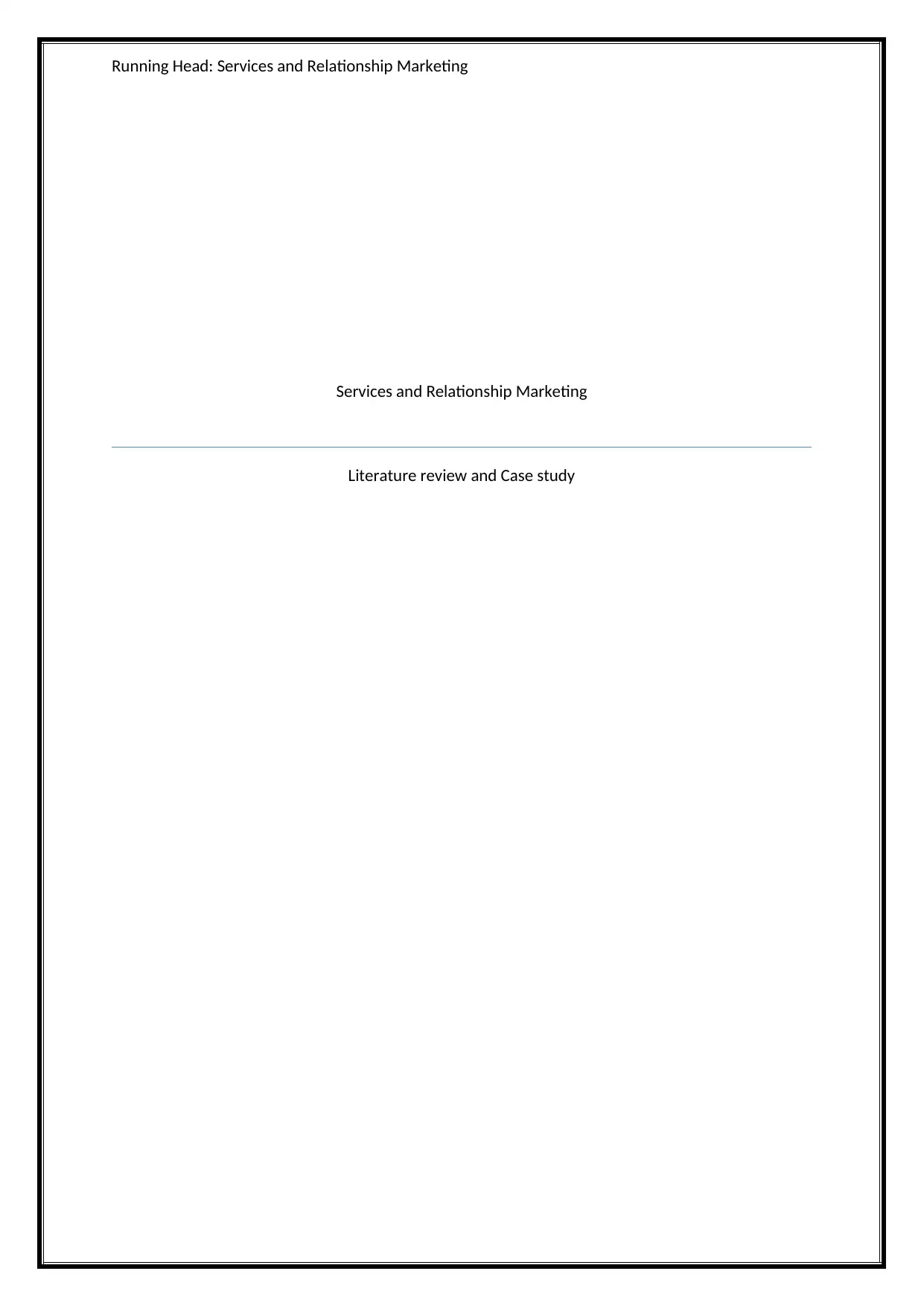
Running Head: Services and Relationship Marketing
Services and Relationship Marketing
Literature review and Case study
Services and Relationship Marketing
Literature review and Case study
Paraphrase This Document
Need a fresh take? Get an instant paraphrase of this document with our AI Paraphraser
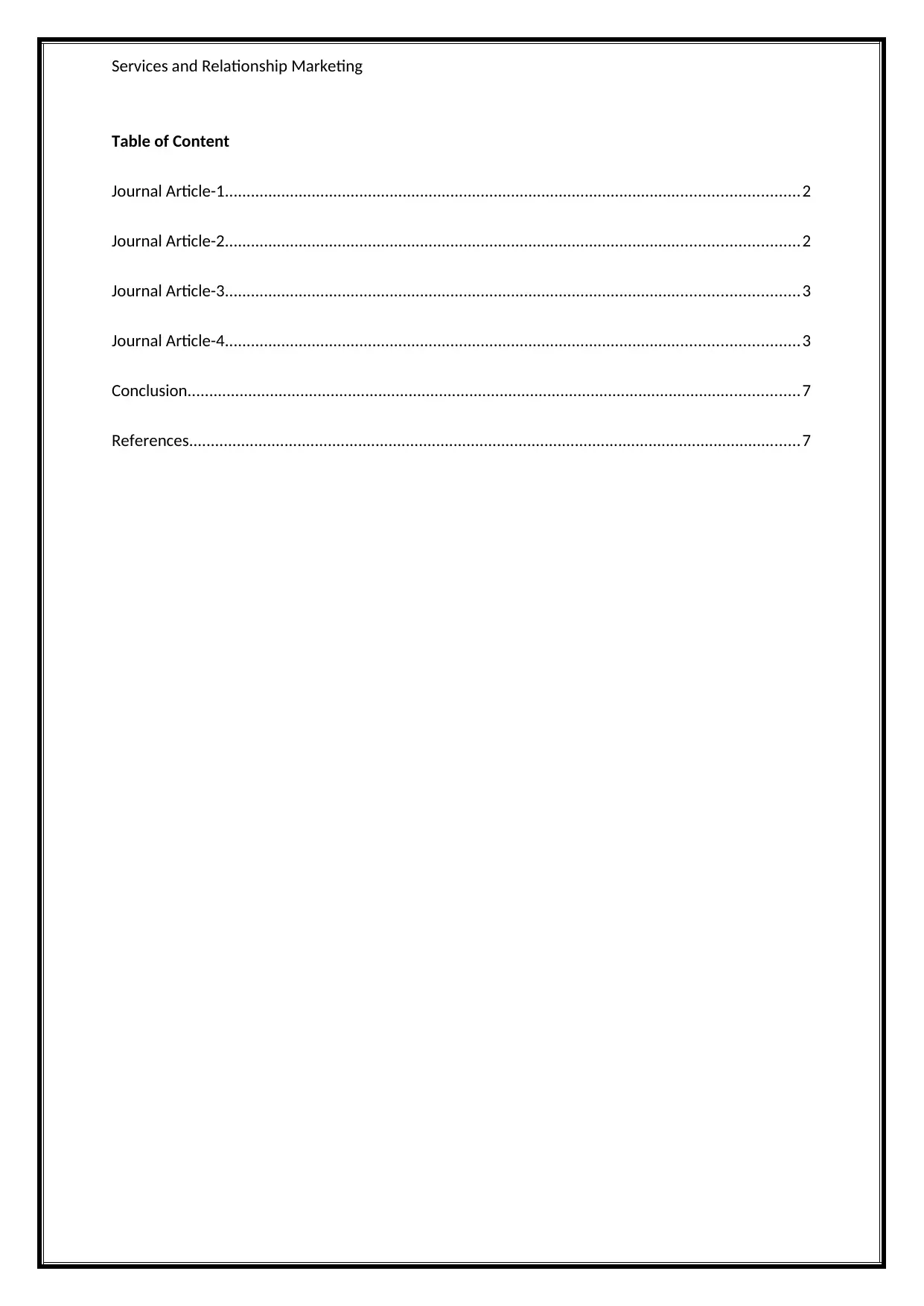
Services and Relationship Marketing
Table of Content
Journal Article-1....................................................................................................................................2
Journal Article-2....................................................................................................................................2
Journal Article-3....................................................................................................................................3
Journal Article-4....................................................................................................................................3
Conclusion.............................................................................................................................................7
References.............................................................................................................................................7
Table of Content
Journal Article-1....................................................................................................................................2
Journal Article-2....................................................................................................................................2
Journal Article-3....................................................................................................................................3
Journal Article-4....................................................................................................................................3
Conclusion.............................................................................................................................................7
References.............................................................................................................................................7
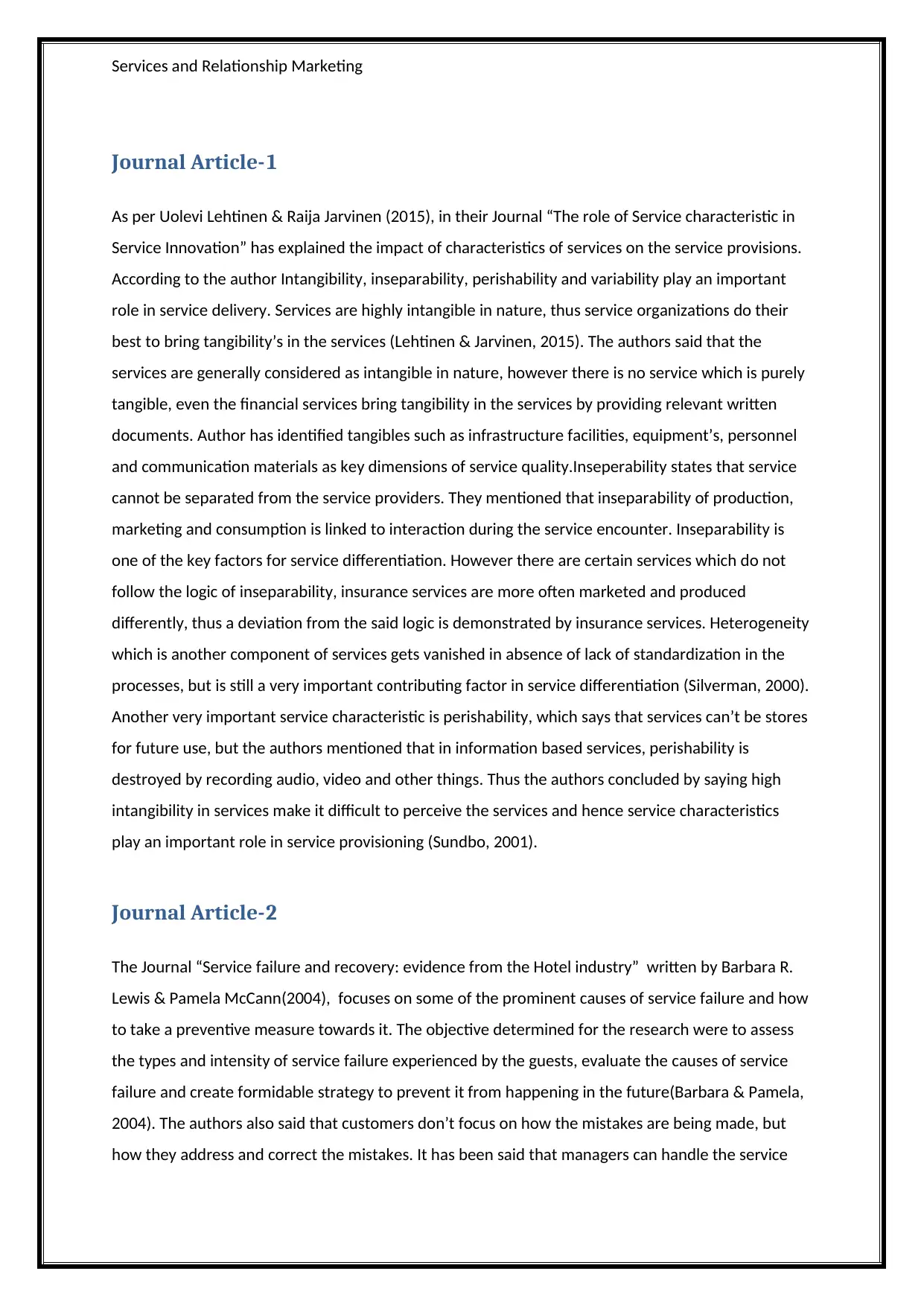
Services and Relationship Marketing
Journal Article-1
As per Uolevi Lehtinen & Raija Jarvinen (2015), in their Journal “The role of Service characteristic in
Service Innovation” has explained the impact of characteristics of services on the service provisions.
According to the author Intangibility, inseparability, perishability and variability play an important
role in service delivery. Services are highly intangible in nature, thus service organizations do their
best to bring tangibility’s in the services (Lehtinen & Jarvinen, 2015). The authors said that the
services are generally considered as intangible in nature, however there is no service which is purely
tangible, even the financial services bring tangibility in the services by providing relevant written
documents. Author has identified tangibles such as infrastructure facilities, equipment’s, personnel
and communication materials as key dimensions of service quality.Inseperability states that service
cannot be separated from the service providers. They mentioned that inseparability of production,
marketing and consumption is linked to interaction during the service encounter. Inseparability is
one of the key factors for service differentiation. However there are certain services which do not
follow the logic of inseparability, insurance services are more often marketed and produced
differently, thus a deviation from the said logic is demonstrated by insurance services. Heterogeneity
which is another component of services gets vanished in absence of lack of standardization in the
processes, but is still a very important contributing factor in service differentiation (Silverman, 2000).
Another very important service characteristic is perishability, which says that services can’t be stores
for future use, but the authors mentioned that in information based services, perishability is
destroyed by recording audio, video and other things. Thus the authors concluded by saying high
intangibility in services make it difficult to perceive the services and hence service characteristics
play an important role in service provisioning (Sundbo, 2001).
Journal Article-2
The Journal “Service failure and recovery: evidence from the Hotel industry” written by Barbara R.
Lewis & Pamela McCann(2004), focuses on some of the prominent causes of service failure and how
to take a preventive measure towards it. The objective determined for the research were to assess
the types and intensity of service failure experienced by the guests, evaluate the causes of service
failure and create formidable strategy to prevent it from happening in the future(Barbara & Pamela,
2004). The authors also said that customers don’t focus on how the mistakes are being made, but
how they address and correct the mistakes. It has been said that managers can handle the service
Journal Article-1
As per Uolevi Lehtinen & Raija Jarvinen (2015), in their Journal “The role of Service characteristic in
Service Innovation” has explained the impact of characteristics of services on the service provisions.
According to the author Intangibility, inseparability, perishability and variability play an important
role in service delivery. Services are highly intangible in nature, thus service organizations do their
best to bring tangibility’s in the services (Lehtinen & Jarvinen, 2015). The authors said that the
services are generally considered as intangible in nature, however there is no service which is purely
tangible, even the financial services bring tangibility in the services by providing relevant written
documents. Author has identified tangibles such as infrastructure facilities, equipment’s, personnel
and communication materials as key dimensions of service quality.Inseperability states that service
cannot be separated from the service providers. They mentioned that inseparability of production,
marketing and consumption is linked to interaction during the service encounter. Inseparability is
one of the key factors for service differentiation. However there are certain services which do not
follow the logic of inseparability, insurance services are more often marketed and produced
differently, thus a deviation from the said logic is demonstrated by insurance services. Heterogeneity
which is another component of services gets vanished in absence of lack of standardization in the
processes, but is still a very important contributing factor in service differentiation (Silverman, 2000).
Another very important service characteristic is perishability, which says that services can’t be stores
for future use, but the authors mentioned that in information based services, perishability is
destroyed by recording audio, video and other things. Thus the authors concluded by saying high
intangibility in services make it difficult to perceive the services and hence service characteristics
play an important role in service provisioning (Sundbo, 2001).
Journal Article-2
The Journal “Service failure and recovery: evidence from the Hotel industry” written by Barbara R.
Lewis & Pamela McCann(2004), focuses on some of the prominent causes of service failure and how
to take a preventive measure towards it. The objective determined for the research were to assess
the types and intensity of service failure experienced by the guests, evaluate the causes of service
failure and create formidable strategy to prevent it from happening in the future(Barbara & Pamela,
2004). The authors also said that customers don’t focus on how the mistakes are being made, but
how they address and correct the mistakes. It has been said that managers can handle the service
⊘ This is a preview!⊘
Do you want full access?
Subscribe today to unlock all pages.

Trusted by 1+ million students worldwide
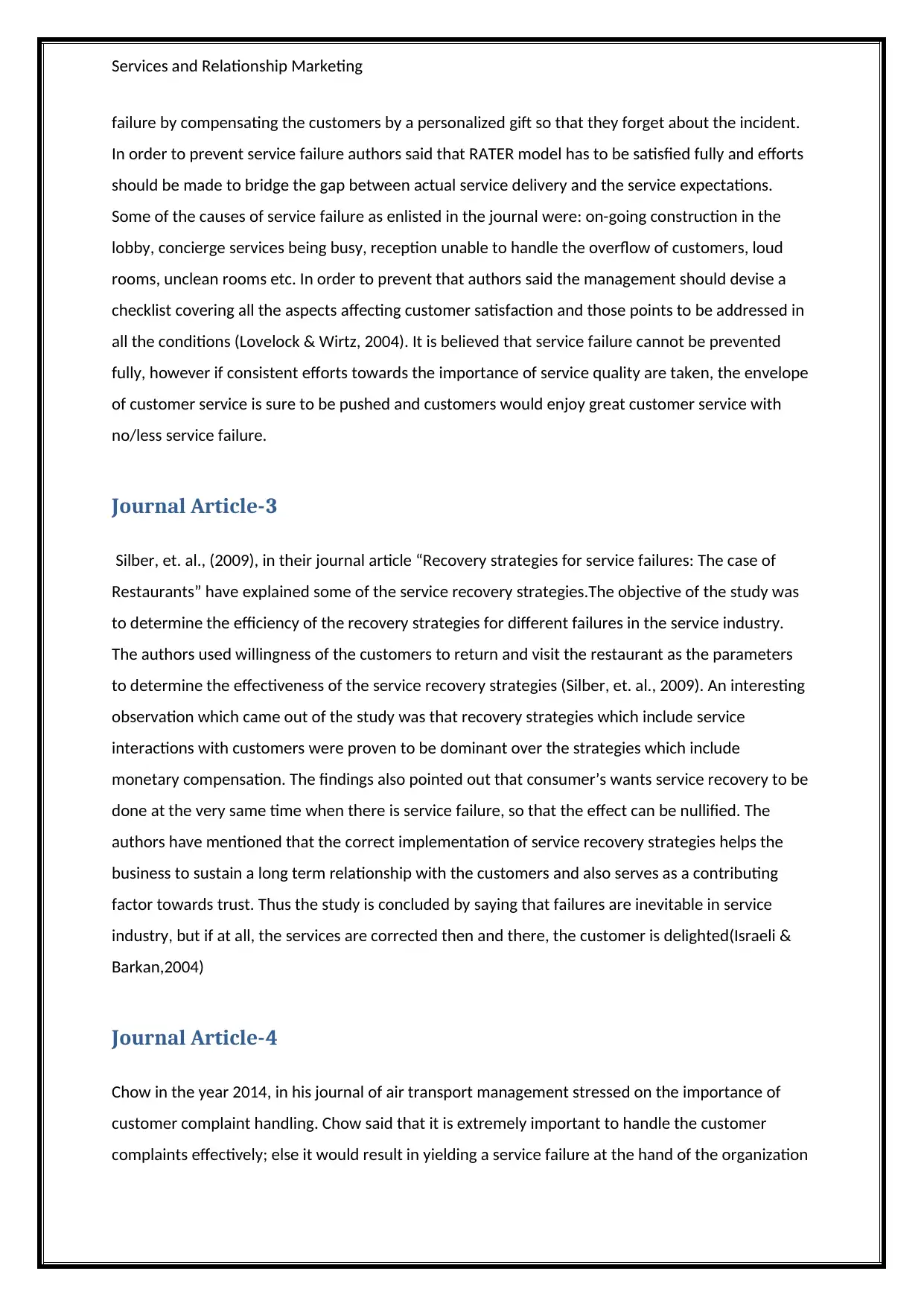
Services and Relationship Marketing
failure by compensating the customers by a personalized gift so that they forget about the incident.
In order to prevent service failure authors said that RATER model has to be satisfied fully and efforts
should be made to bridge the gap between actual service delivery and the service expectations.
Some of the causes of service failure as enlisted in the journal were: on-going construction in the
lobby, concierge services being busy, reception unable to handle the overflow of customers, loud
rooms, unclean rooms etc. In order to prevent that authors said the management should devise a
checklist covering all the aspects affecting customer satisfaction and those points to be addressed in
all the conditions (Lovelock & Wirtz, 2004). It is believed that service failure cannot be prevented
fully, however if consistent efforts towards the importance of service quality are taken, the envelope
of customer service is sure to be pushed and customers would enjoy great customer service with
no/less service failure.
Journal Article-3
Silber, et. al., (2009), in their journal article “Recovery strategies for service failures: The case of
Restaurants” have explained some of the service recovery strategies.The objective of the study was
to determine the efficiency of the recovery strategies for different failures in the service industry.
The authors used willingness of the customers to return and visit the restaurant as the parameters
to determine the effectiveness of the service recovery strategies (Silber, et. al., 2009). An interesting
observation which came out of the study was that recovery strategies which include service
interactions with customers were proven to be dominant over the strategies which include
monetary compensation. The findings also pointed out that consumer’s wants service recovery to be
done at the very same time when there is service failure, so that the effect can be nullified. The
authors have mentioned that the correct implementation of service recovery strategies helps the
business to sustain a long term relationship with the customers and also serves as a contributing
factor towards trust. Thus the study is concluded by saying that failures are inevitable in service
industry, but if at all, the services are corrected then and there, the customer is delighted(Israeli &
Barkan,2004)
Journal Article-4
Chow in the year 2014, in his journal of air transport management stressed on the importance of
customer complaint handling. Chow said that it is extremely important to handle the customer
complaints effectively; else it would result in yielding a service failure at the hand of the organization
failure by compensating the customers by a personalized gift so that they forget about the incident.
In order to prevent service failure authors said that RATER model has to be satisfied fully and efforts
should be made to bridge the gap between actual service delivery and the service expectations.
Some of the causes of service failure as enlisted in the journal were: on-going construction in the
lobby, concierge services being busy, reception unable to handle the overflow of customers, loud
rooms, unclean rooms etc. In order to prevent that authors said the management should devise a
checklist covering all the aspects affecting customer satisfaction and those points to be addressed in
all the conditions (Lovelock & Wirtz, 2004). It is believed that service failure cannot be prevented
fully, however if consistent efforts towards the importance of service quality are taken, the envelope
of customer service is sure to be pushed and customers would enjoy great customer service with
no/less service failure.
Journal Article-3
Silber, et. al., (2009), in their journal article “Recovery strategies for service failures: The case of
Restaurants” have explained some of the service recovery strategies.The objective of the study was
to determine the efficiency of the recovery strategies for different failures in the service industry.
The authors used willingness of the customers to return and visit the restaurant as the parameters
to determine the effectiveness of the service recovery strategies (Silber, et. al., 2009). An interesting
observation which came out of the study was that recovery strategies which include service
interactions with customers were proven to be dominant over the strategies which include
monetary compensation. The findings also pointed out that consumer’s wants service recovery to be
done at the very same time when there is service failure, so that the effect can be nullified. The
authors have mentioned that the correct implementation of service recovery strategies helps the
business to sustain a long term relationship with the customers and also serves as a contributing
factor towards trust. Thus the study is concluded by saying that failures are inevitable in service
industry, but if at all, the services are corrected then and there, the customer is delighted(Israeli &
Barkan,2004)
Journal Article-4
Chow in the year 2014, in his journal of air transport management stressed on the importance of
customer complaint handling. Chow said that it is extremely important to handle the customer
complaints effectively; else it would result in yielding a service failure at the hand of the organization
Paraphrase This Document
Need a fresh take? Get an instant paraphrase of this document with our AI Paraphraser
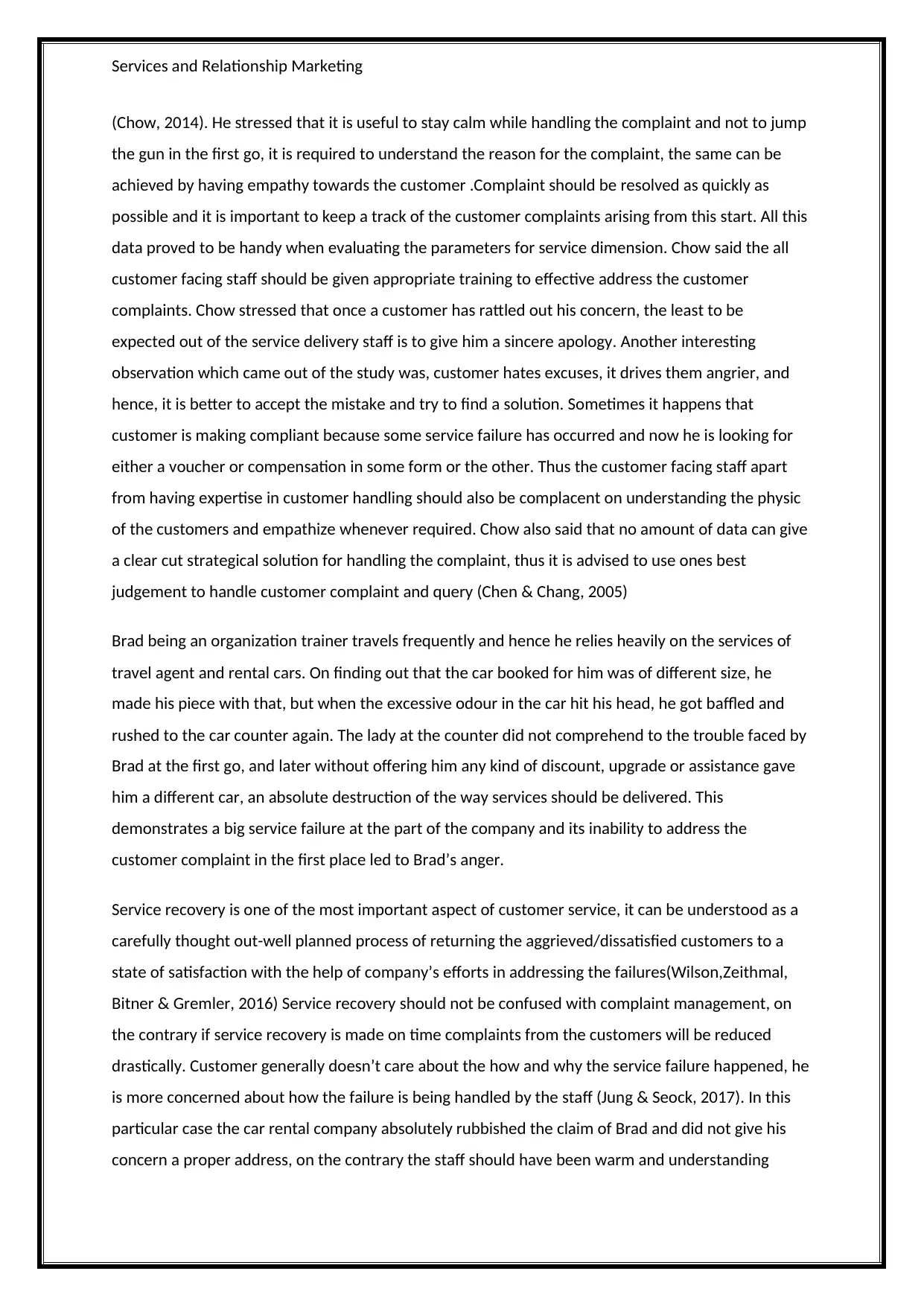
Services and Relationship Marketing
(Chow, 2014). He stressed that it is useful to stay calm while handling the complaint and not to jump
the gun in the first go, it is required to understand the reason for the complaint, the same can be
achieved by having empathy towards the customer .Complaint should be resolved as quickly as
possible and it is important to keep a track of the customer complaints arising from this start. All this
data proved to be handy when evaluating the parameters for service dimension. Chow said the all
customer facing staff should be given appropriate training to effective address the customer
complaints. Chow stressed that once a customer has rattled out his concern, the least to be
expected out of the service delivery staff is to give him a sincere apology. Another interesting
observation which came out of the study was, customer hates excuses, it drives them angrier, and
hence, it is better to accept the mistake and try to find a solution. Sometimes it happens that
customer is making compliant because some service failure has occurred and now he is looking for
either a voucher or compensation in some form or the other. Thus the customer facing staff apart
from having expertise in customer handling should also be complacent on understanding the physic
of the customers and empathize whenever required. Chow also said that no amount of data can give
a clear cut strategical solution for handling the complaint, thus it is advised to use ones best
judgement to handle customer complaint and query (Chen & Chang, 2005)
Brad being an organization trainer travels frequently and hence he relies heavily on the services of
travel agent and rental cars. On finding out that the car booked for him was of different size, he
made his piece with that, but when the excessive odour in the car hit his head, he got baffled and
rushed to the car counter again. The lady at the counter did not comprehend to the trouble faced by
Brad at the first go, and later without offering him any kind of discount, upgrade or assistance gave
him a different car, an absolute destruction of the way services should be delivered. This
demonstrates a big service failure at the part of the company and its inability to address the
customer complaint in the first place led to Brad’s anger.
Service recovery is one of the most important aspect of customer service, it can be understood as a
carefully thought out-well planned process of returning the aggrieved/dissatisfied customers to a
state of satisfaction with the help of company’s efforts in addressing the failures(Wilson,Zeithmal,
Bitner & Gremler, 2016) Service recovery should not be confused with complaint management, on
the contrary if service recovery is made on time complaints from the customers will be reduced
drastically. Customer generally doesn’t care about the how and why the service failure happened, he
is more concerned about how the failure is being handled by the staff (Jung & Seock, 2017). In this
particular case the car rental company absolutely rubbished the claim of Brad and did not give his
concern a proper address, on the contrary the staff should have been warm and understanding
(Chow, 2014). He stressed that it is useful to stay calm while handling the complaint and not to jump
the gun in the first go, it is required to understand the reason for the complaint, the same can be
achieved by having empathy towards the customer .Complaint should be resolved as quickly as
possible and it is important to keep a track of the customer complaints arising from this start. All this
data proved to be handy when evaluating the parameters for service dimension. Chow said the all
customer facing staff should be given appropriate training to effective address the customer
complaints. Chow stressed that once a customer has rattled out his concern, the least to be
expected out of the service delivery staff is to give him a sincere apology. Another interesting
observation which came out of the study was, customer hates excuses, it drives them angrier, and
hence, it is better to accept the mistake and try to find a solution. Sometimes it happens that
customer is making compliant because some service failure has occurred and now he is looking for
either a voucher or compensation in some form or the other. Thus the customer facing staff apart
from having expertise in customer handling should also be complacent on understanding the physic
of the customers and empathize whenever required. Chow also said that no amount of data can give
a clear cut strategical solution for handling the complaint, thus it is advised to use ones best
judgement to handle customer complaint and query (Chen & Chang, 2005)
Brad being an organization trainer travels frequently and hence he relies heavily on the services of
travel agent and rental cars. On finding out that the car booked for him was of different size, he
made his piece with that, but when the excessive odour in the car hit his head, he got baffled and
rushed to the car counter again. The lady at the counter did not comprehend to the trouble faced by
Brad at the first go, and later without offering him any kind of discount, upgrade or assistance gave
him a different car, an absolute destruction of the way services should be delivered. This
demonstrates a big service failure at the part of the company and its inability to address the
customer complaint in the first place led to Brad’s anger.
Service recovery is one of the most important aspect of customer service, it can be understood as a
carefully thought out-well planned process of returning the aggrieved/dissatisfied customers to a
state of satisfaction with the help of company’s efforts in addressing the failures(Wilson,Zeithmal,
Bitner & Gremler, 2016) Service recovery should not be confused with complaint management, on
the contrary if service recovery is made on time complaints from the customers will be reduced
drastically. Customer generally doesn’t care about the how and why the service failure happened, he
is more concerned about how the failure is being handled by the staff (Jung & Seock, 2017). In this
particular case the car rental company absolutely rubbished the claim of Brad and did not give his
concern a proper address, on the contrary the staff should have been warm and understanding
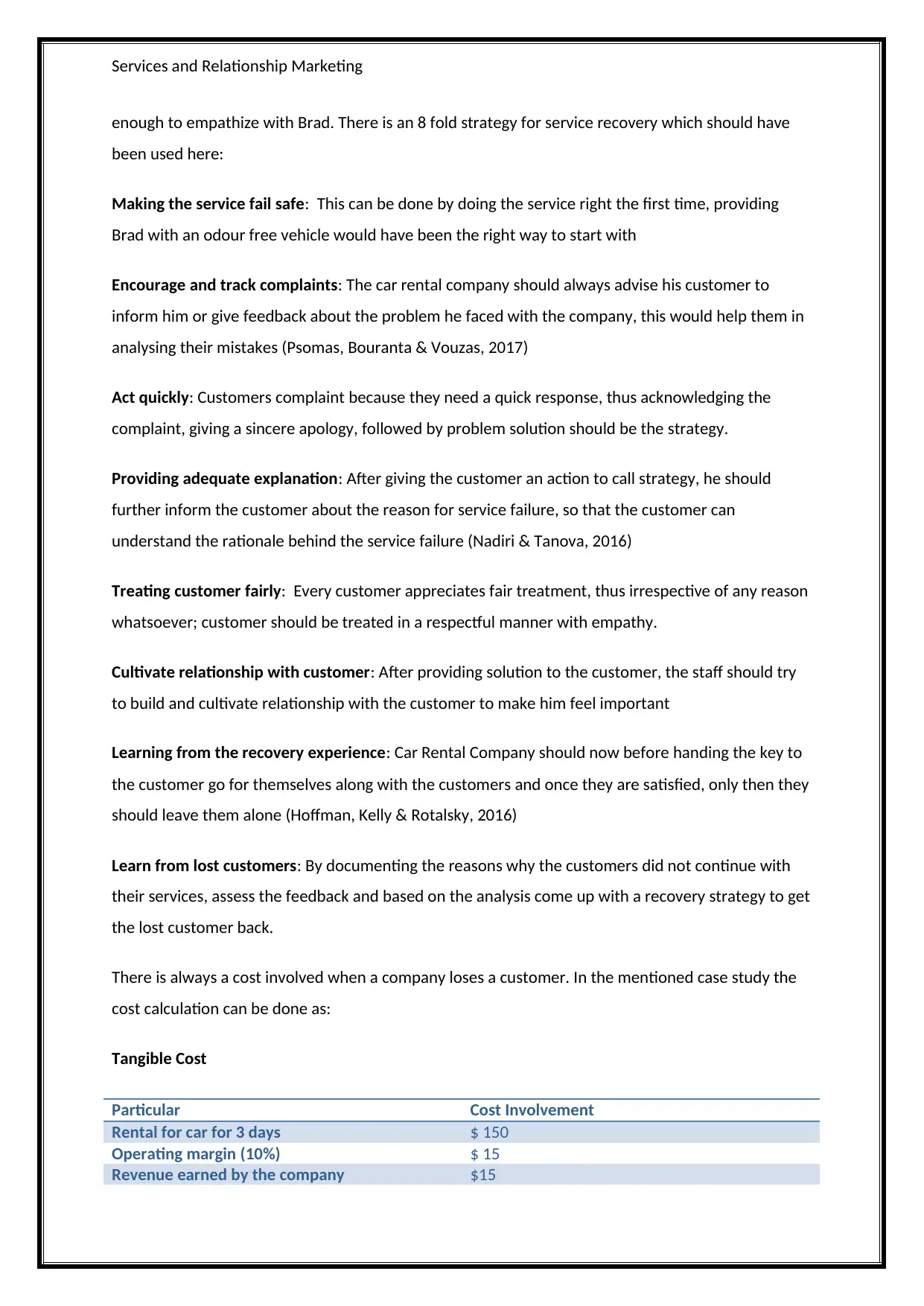
Services and Relationship Marketing
enough to empathize with Brad. There is an 8 fold strategy for service recovery which should have
been used here:
Making the service fail safe: This can be done by doing the service right the first time, providing
Brad with an odour free vehicle would have been the right way to start with
Encourage and track complaints: The car rental company should always advise his customer to
inform him or give feedback about the problem he faced with the company, this would help them in
analysing their mistakes (Psomas, Bouranta & Vouzas, 2017)
Act quickly: Customers complaint because they need a quick response, thus acknowledging the
complaint, giving a sincere apology, followed by problem solution should be the strategy.
Providing adequate explanation: After giving the customer an action to call strategy, he should
further inform the customer about the reason for service failure, so that the customer can
understand the rationale behind the service failure (Nadiri & Tanova, 2016)
Treating customer fairly: Every customer appreciates fair treatment, thus irrespective of any reason
whatsoever; customer should be treated in a respectful manner with empathy.
Cultivate relationship with customer: After providing solution to the customer, the staff should try
to build and cultivate relationship with the customer to make him feel important
Learning from the recovery experience: Car Rental Company should now before handing the key to
the customer go for themselves along with the customers and once they are satisfied, only then they
should leave them alone (Hoffman, Kelly & Rotalsky, 2016)
Learn from lost customers: By documenting the reasons why the customers did not continue with
their services, assess the feedback and based on the analysis come up with a recovery strategy to get
the lost customer back.
There is always a cost involved when a company loses a customer. In the mentioned case study the
cost calculation can be done as:
Tangible Cost
Particular Cost Involvement
Rental for car for 3 days $ 150
Operating margin (10%) $ 15
Revenue earned by the company $15
enough to empathize with Brad. There is an 8 fold strategy for service recovery which should have
been used here:
Making the service fail safe: This can be done by doing the service right the first time, providing
Brad with an odour free vehicle would have been the right way to start with
Encourage and track complaints: The car rental company should always advise his customer to
inform him or give feedback about the problem he faced with the company, this would help them in
analysing their mistakes (Psomas, Bouranta & Vouzas, 2017)
Act quickly: Customers complaint because they need a quick response, thus acknowledging the
complaint, giving a sincere apology, followed by problem solution should be the strategy.
Providing adequate explanation: After giving the customer an action to call strategy, he should
further inform the customer about the reason for service failure, so that the customer can
understand the rationale behind the service failure (Nadiri & Tanova, 2016)
Treating customer fairly: Every customer appreciates fair treatment, thus irrespective of any reason
whatsoever; customer should be treated in a respectful manner with empathy.
Cultivate relationship with customer: After providing solution to the customer, the staff should try
to build and cultivate relationship with the customer to make him feel important
Learning from the recovery experience: Car Rental Company should now before handing the key to
the customer go for themselves along with the customers and once they are satisfied, only then they
should leave them alone (Hoffman, Kelly & Rotalsky, 2016)
Learn from lost customers: By documenting the reasons why the customers did not continue with
their services, assess the feedback and based on the analysis come up with a recovery strategy to get
the lost customer back.
There is always a cost involved when a company loses a customer. In the mentioned case study the
cost calculation can be done as:
Tangible Cost
Particular Cost Involvement
Rental for car for 3 days $ 150
Operating margin (10%) $ 15
Revenue earned by the company $15
⊘ This is a preview!⊘
Do you want full access?
Subscribe today to unlock all pages.

Trusted by 1+ million students worldwide
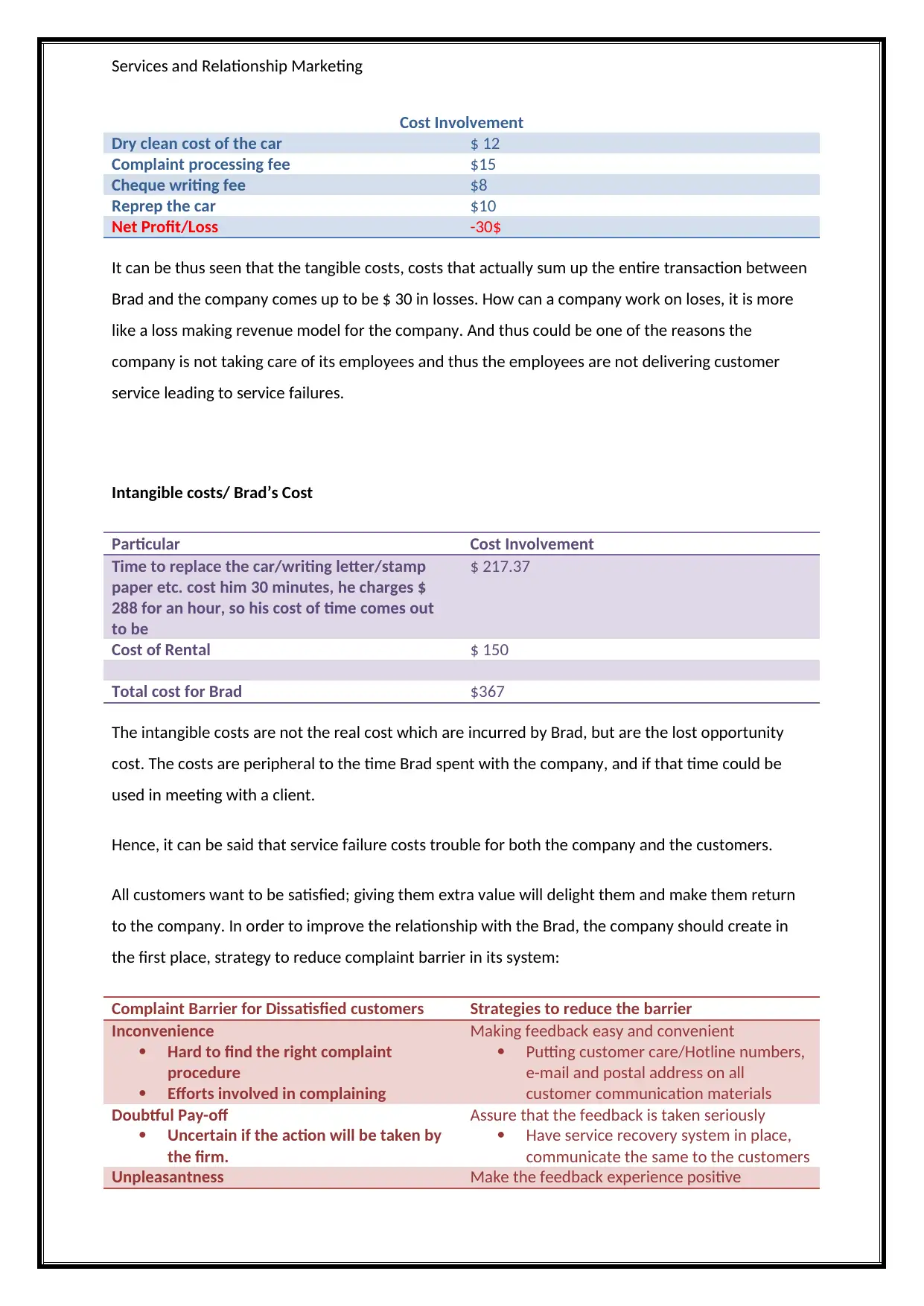
Services and Relationship Marketing
Cost Involvement
Dry clean cost of the car $ 12
Complaint processing fee $15
Cheque writing fee $8
Reprep the car $10
Net Profit/Loss -30$
It can be thus seen that the tangible costs, costs that actually sum up the entire transaction between
Brad and the company comes up to be $ 30 in losses. How can a company work on loses, it is more
like a loss making revenue model for the company. And thus could be one of the reasons the
company is not taking care of its employees and thus the employees are not delivering customer
service leading to service failures.
Intangible costs/ Brad’s Cost
Particular Cost Involvement
Time to replace the car/writing letter/stamp
paper etc. cost him 30 minutes, he charges $
288 for an hour, so his cost of time comes out
to be
$ 217.37
Cost of Rental $ 150
Total cost for Brad $367
The intangible costs are not the real cost which are incurred by Brad, but are the lost opportunity
cost. The costs are peripheral to the time Brad spent with the company, and if that time could be
used in meeting with a client.
Hence, it can be said that service failure costs trouble for both the company and the customers.
All customers want to be satisfied; giving them extra value will delight them and make them return
to the company. In order to improve the relationship with the Brad, the company should create in
the first place, strategy to reduce complaint barrier in its system:
Complaint Barrier for Dissatisfied customers Strategies to reduce the barrier
Inconvenience
Hard to find the right complaint
procedure
Efforts involved in complaining
Making feedback easy and convenient
Putting customer care/Hotline numbers,
e-mail and postal address on all
customer communication materials
Doubtful Pay-off
Uncertain if the action will be taken by
the firm.
Assure that the feedback is taken seriously
Have service recovery system in place,
communicate the same to the customers
Unpleasantness Make the feedback experience positive
Cost Involvement
Dry clean cost of the car $ 12
Complaint processing fee $15
Cheque writing fee $8
Reprep the car $10
Net Profit/Loss -30$
It can be thus seen that the tangible costs, costs that actually sum up the entire transaction between
Brad and the company comes up to be $ 30 in losses. How can a company work on loses, it is more
like a loss making revenue model for the company. And thus could be one of the reasons the
company is not taking care of its employees and thus the employees are not delivering customer
service leading to service failures.
Intangible costs/ Brad’s Cost
Particular Cost Involvement
Time to replace the car/writing letter/stamp
paper etc. cost him 30 minutes, he charges $
288 for an hour, so his cost of time comes out
to be
$ 217.37
Cost of Rental $ 150
Total cost for Brad $367
The intangible costs are not the real cost which are incurred by Brad, but are the lost opportunity
cost. The costs are peripheral to the time Brad spent with the company, and if that time could be
used in meeting with a client.
Hence, it can be said that service failure costs trouble for both the company and the customers.
All customers want to be satisfied; giving them extra value will delight them and make them return
to the company. In order to improve the relationship with the Brad, the company should create in
the first place, strategy to reduce complaint barrier in its system:
Complaint Barrier for Dissatisfied customers Strategies to reduce the barrier
Inconvenience
Hard to find the right complaint
procedure
Efforts involved in complaining
Making feedback easy and convenient
Putting customer care/Hotline numbers,
e-mail and postal address on all
customer communication materials
Doubtful Pay-off
Uncertain if the action will be taken by
the firm.
Assure that the feedback is taken seriously
Have service recovery system in place,
communicate the same to the customers
Unpleasantness Make the feedback experience positive
Paraphrase This Document
Need a fresh take? Get an instant paraphrase of this document with our AI Paraphraser
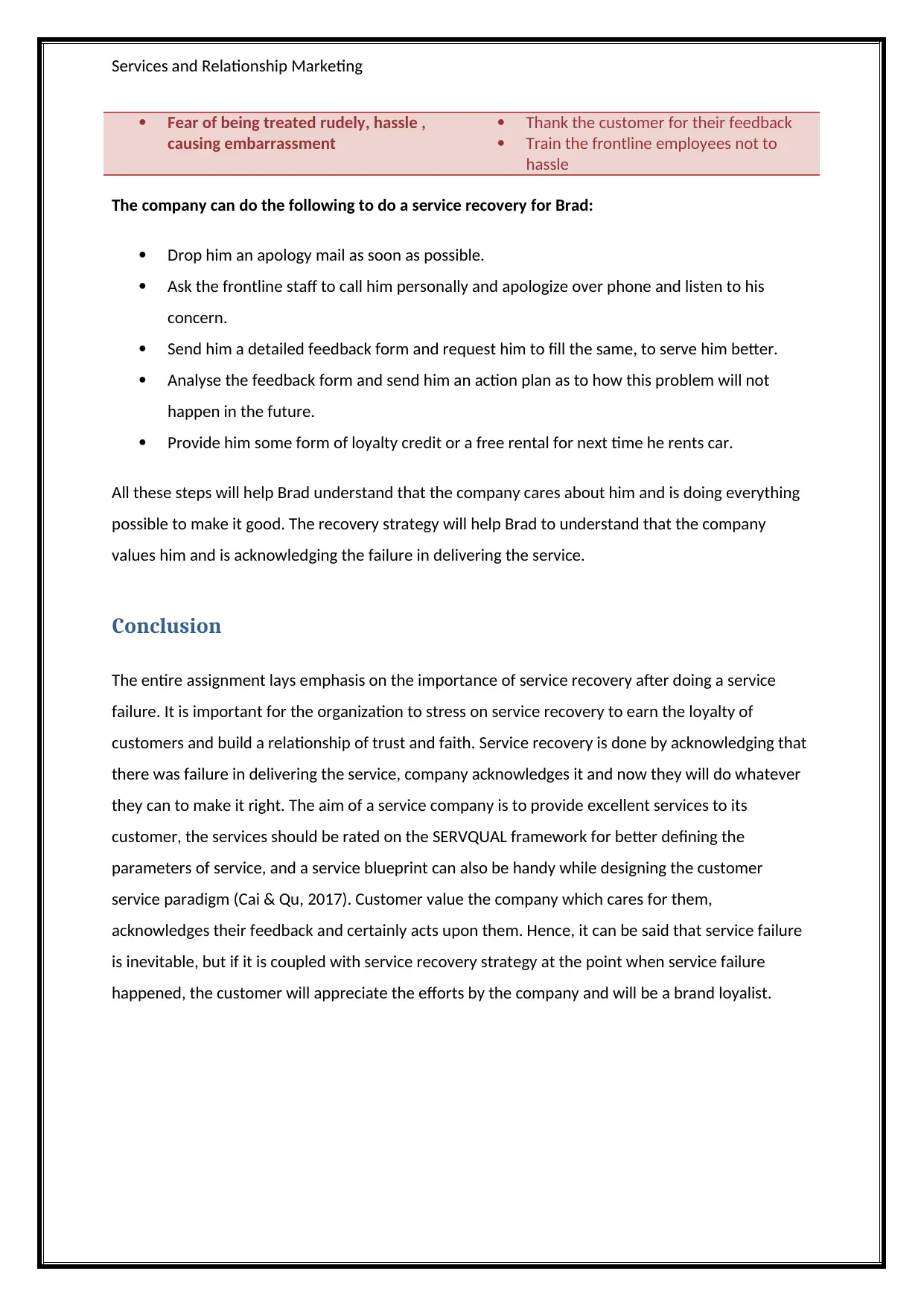
Services and Relationship Marketing
Fear of being treated rudely, hassle ,
causing embarrassment
Thank the customer for their feedback
Train the frontline employees not to
hassle
The company can do the following to do a service recovery for Brad:
Drop him an apology mail as soon as possible.
Ask the frontline staff to call him personally and apologize over phone and listen to his
concern.
Send him a detailed feedback form and request him to fill the same, to serve him better.
Analyse the feedback form and send him an action plan as to how this problem will not
happen in the future.
Provide him some form of loyalty credit or a free rental for next time he rents car.
All these steps will help Brad understand that the company cares about him and is doing everything
possible to make it good. The recovery strategy will help Brad to understand that the company
values him and is acknowledging the failure in delivering the service.
Conclusion
The entire assignment lays emphasis on the importance of service recovery after doing a service
failure. It is important for the organization to stress on service recovery to earn the loyalty of
customers and build a relationship of trust and faith. Service recovery is done by acknowledging that
there was failure in delivering the service, company acknowledges it and now they will do whatever
they can to make it right. The aim of a service company is to provide excellent services to its
customer, the services should be rated on the SERVQUAL framework for better defining the
parameters of service, and a service blueprint can also be handy while designing the customer
service paradigm (Cai & Qu, 2017). Customer value the company which cares for them,
acknowledges their feedback and certainly acts upon them. Hence, it can be said that service failure
is inevitable, but if it is coupled with service recovery strategy at the point when service failure
happened, the customer will appreciate the efforts by the company and will be a brand loyalist.
Fear of being treated rudely, hassle ,
causing embarrassment
Thank the customer for their feedback
Train the frontline employees not to
hassle
The company can do the following to do a service recovery for Brad:
Drop him an apology mail as soon as possible.
Ask the frontline staff to call him personally and apologize over phone and listen to his
concern.
Send him a detailed feedback form and request him to fill the same, to serve him better.
Analyse the feedback form and send him an action plan as to how this problem will not
happen in the future.
Provide him some form of loyalty credit or a free rental for next time he rents car.
All these steps will help Brad understand that the company cares about him and is doing everything
possible to make it good. The recovery strategy will help Brad to understand that the company
values him and is acknowledging the failure in delivering the service.
Conclusion
The entire assignment lays emphasis on the importance of service recovery after doing a service
failure. It is important for the organization to stress on service recovery to earn the loyalty of
customers and build a relationship of trust and faith. Service recovery is done by acknowledging that
there was failure in delivering the service, company acknowledges it and now they will do whatever
they can to make it right. The aim of a service company is to provide excellent services to its
customer, the services should be rated on the SERVQUAL framework for better defining the
parameters of service, and a service blueprint can also be handy while designing the customer
service paradigm (Cai & Qu, 2017). Customer value the company which cares for them,
acknowledges their feedback and certainly acts upon them. Hence, it can be said that service failure
is inevitable, but if it is coupled with service recovery strategy at the point when service failure
happened, the customer will appreciate the efforts by the company and will be a brand loyalist.
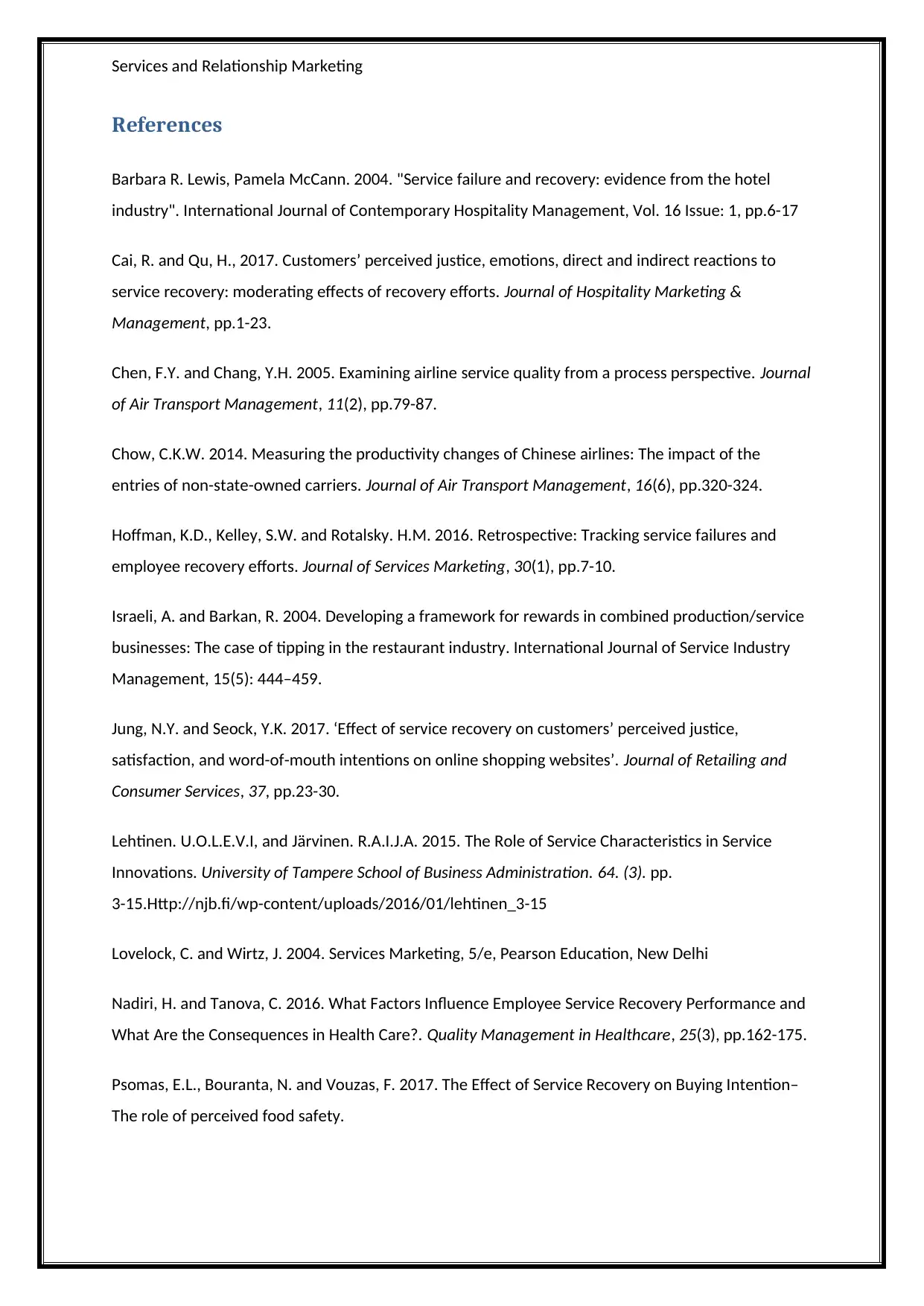
Services and Relationship Marketing
References
Barbara R. Lewis, Pamela McCann. 2004. "Service failure and recovery: evidence from the hotel
industry". International Journal of Contemporary Hospitality Management, Vol. 16 Issue: 1, pp.6-17
Cai, R. and Qu, H., 2017. Customers’ perceived justice, emotions, direct and indirect reactions to
service recovery: moderating effects of recovery efforts. Journal of Hospitality Marketing &
Management, pp.1-23.
Chen, F.Y. and Chang, Y.H. 2005. Examining airline service quality from a process perspective. Journal
of Air Transport Management, 11(2), pp.79-87.
Chow, C.K.W. 2014. Measuring the productivity changes of Chinese airlines: The impact of the
entries of non-state-owned carriers. Journal of Air Transport Management, 16(6), pp.320-324.
Hoffman, K.D., Kelley, S.W. and Rotalsky. H.M. 2016. Retrospective: Tracking service failures and
employee recovery efforts. Journal of Services Marketing, 30(1), pp.7-10.
Israeli, A. and Barkan, R. 2004. Developing a framework for rewards in combined production/service
businesses: The case of tipping in the restaurant industry. International Journal of Service Industry
Management, 15(5): 444–459.
Jung, N.Y. and Seock, Y.K. 2017. ‘Effect of service recovery on customers’ perceived justice,
satisfaction, and word-of-mouth intentions on online shopping websites’. Journal of Retailing and
Consumer Services, 37, pp.23-30.
Lehtinen. U.O.L.E.V.I, and Järvinen. R.A.I.J.A. 2015. The Role of Service Characteristics in Service
Innovations. University of Tampere School of Business Administration. 64. (3). pp.
3-15.Http://njb.fi/wp-content/uploads/2016/01/lehtinen_3-15
Lovelock, C. and Wirtz, J. 2004. Services Marketing, 5/e, Pearson Education, New Delhi
Nadiri, H. and Tanova, C. 2016. What Factors Influence Employee Service Recovery Performance and
What Are the Consequences in Health Care?. Quality Management in Healthcare, 25(3), pp.162-175.
Psomas, E.L., Bouranta, N. and Vouzas, F. 2017. The Effect of Service Recovery on Buying Intention–
The role of perceived food safety.
References
Barbara R. Lewis, Pamela McCann. 2004. "Service failure and recovery: evidence from the hotel
industry". International Journal of Contemporary Hospitality Management, Vol. 16 Issue: 1, pp.6-17
Cai, R. and Qu, H., 2017. Customers’ perceived justice, emotions, direct and indirect reactions to
service recovery: moderating effects of recovery efforts. Journal of Hospitality Marketing &
Management, pp.1-23.
Chen, F.Y. and Chang, Y.H. 2005. Examining airline service quality from a process perspective. Journal
of Air Transport Management, 11(2), pp.79-87.
Chow, C.K.W. 2014. Measuring the productivity changes of Chinese airlines: The impact of the
entries of non-state-owned carriers. Journal of Air Transport Management, 16(6), pp.320-324.
Hoffman, K.D., Kelley, S.W. and Rotalsky. H.M. 2016. Retrospective: Tracking service failures and
employee recovery efforts. Journal of Services Marketing, 30(1), pp.7-10.
Israeli, A. and Barkan, R. 2004. Developing a framework for rewards in combined production/service
businesses: The case of tipping in the restaurant industry. International Journal of Service Industry
Management, 15(5): 444–459.
Jung, N.Y. and Seock, Y.K. 2017. ‘Effect of service recovery on customers’ perceived justice,
satisfaction, and word-of-mouth intentions on online shopping websites’. Journal of Retailing and
Consumer Services, 37, pp.23-30.
Lehtinen. U.O.L.E.V.I, and Järvinen. R.A.I.J.A. 2015. The Role of Service Characteristics in Service
Innovations. University of Tampere School of Business Administration. 64. (3). pp.
3-15.Http://njb.fi/wp-content/uploads/2016/01/lehtinen_3-15
Lovelock, C. and Wirtz, J. 2004. Services Marketing, 5/e, Pearson Education, New Delhi
Nadiri, H. and Tanova, C. 2016. What Factors Influence Employee Service Recovery Performance and
What Are the Consequences in Health Care?. Quality Management in Healthcare, 25(3), pp.162-175.
Psomas, E.L., Bouranta, N. and Vouzas, F. 2017. The Effect of Service Recovery on Buying Intention–
The role of perceived food safety.
⊘ This is a preview!⊘
Do you want full access?
Subscribe today to unlock all pages.

Trusted by 1+ million students worldwide
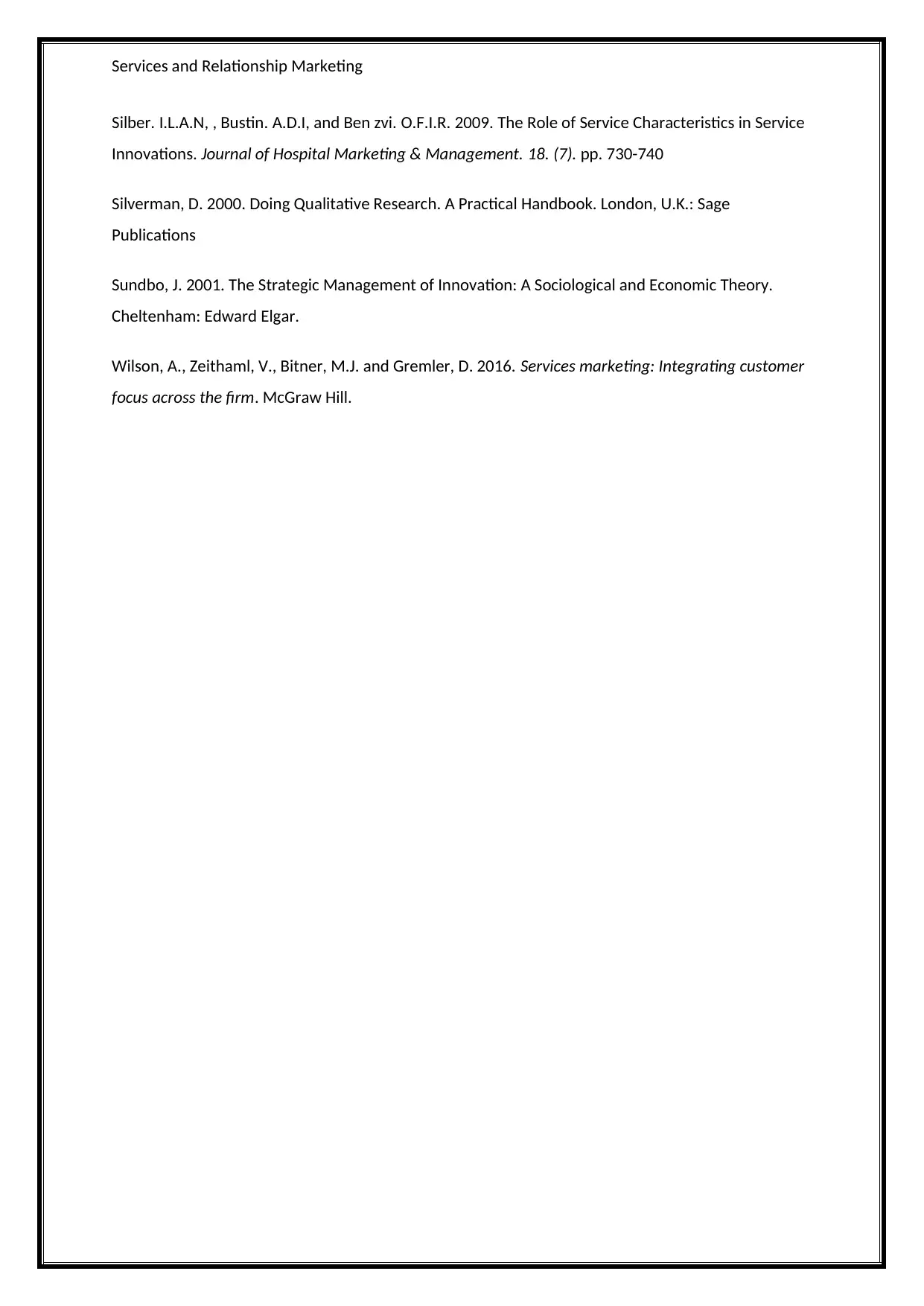
Services and Relationship Marketing
Silber. I.L.A.N, , Bustin. A.D.I, and Ben zvi. O.F.I.R. 2009. The Role of Service Characteristics in Service
Innovations. Journal of Hospital Marketing & Management. 18. (7). pp. 730-740
Silverman, D. 2000. Doing Qualitative Research. A Practical Handbook. London, U.K.: Sage
Publications
Sundbo, J. 2001. The Strategic Management of Innovation: A Sociological and Economic Theory.
Cheltenham: Edward Elgar.
Wilson, A., Zeithaml, V., Bitner, M.J. and Gremler, D. 2016. Services marketing: Integrating customer
focus across the firm. McGraw Hill.
Silber. I.L.A.N, , Bustin. A.D.I, and Ben zvi. O.F.I.R. 2009. The Role of Service Characteristics in Service
Innovations. Journal of Hospital Marketing & Management. 18. (7). pp. 730-740
Silverman, D. 2000. Doing Qualitative Research. A Practical Handbook. London, U.K.: Sage
Publications
Sundbo, J. 2001. The Strategic Management of Innovation: A Sociological and Economic Theory.
Cheltenham: Edward Elgar.
Wilson, A., Zeithaml, V., Bitner, M.J. and Gremler, D. 2016. Services marketing: Integrating customer
focus across the firm. McGraw Hill.
1 out of 10
Your All-in-One AI-Powered Toolkit for Academic Success.
+13062052269
info@desklib.com
Available 24*7 on WhatsApp / Email
![[object Object]](/_next/static/media/star-bottom.7253800d.svg)
Unlock your academic potential
Copyright © 2020–2025 A2Z Services. All Rights Reserved. Developed and managed by ZUCOL.